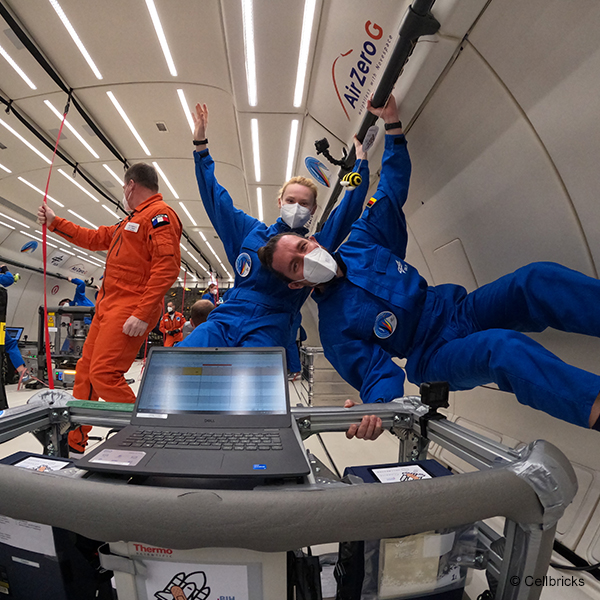Interview with: Prof. Georg N. Duda and Bianca Lemke, Charité and cooperation partner Dr. Lutz Kloke, Cellbricks

How did the parabolic flights come about and what steps into space are planned next?
Prof. Duda: The German Aerospace Center (DLR) is very interested in life science research. After all, we’re talking about big plans: staying on a space station and flights to Mars. All of this requires being able to provide medical assistance at short notice. Individualized and so-called “advanced therapies” are the focus of our research center at the BIH. We develop innovative therapies to support the body’s own healing processes and, in doing so, try to prevent scaring and loss of function. In addition to bone fractures and muscle injuries, healing skin wounds is another field where we’d like to put our principles of individualized therapies into practice. Parabolic flights are a method of testing technology in zero gravity conditions. If the 3D bioprint works there, it can work pretty much anywhere. We of course test the effectiveness of the therapy itself under the specified regulatory framework conditions.
Ms. Lemke, you were on board for the experiments. How did you find working and collaborating with colleagues?
Bianca Lemke: I found the parabolic flight initiative very exciting. Collaboration with our cooperation partner Cellbricks was highly professional. We were a great team. After a few stressful days preparing the acceptance of our experiment, we were finally able to carry out three parabolic flights. Our thorough preparation payed off: the 3D printing worked surprisingly well and the initial results look very promising.
The issue of wound closure remains fundamentally very challenging, even on earth. Where do we stand on it today?
Bianca Lemke: When treating extensive burn wounds in particular, it’s vital to close the wound because of the risk of infection and the slow healing process. The most successful treatment method here is still the autologous skin graft. Although there are skin grafts produced in a laboratory, these often have a poorer chance of healing and are often rejected. There therefore continues to be a great demand for developing new solutions for such critical wounds in patients.
What other additive manufacturing applications can we expect for medicine and the healthcare industry?
Dr. Kloke: Additive manufacturing is increasingly growing into the areas of medicine, biotechnology and regenerative methods at the moment. This networking is taking place gradually and with increasing complexity in the applications. In regenerative medicine, it’s highly unlikely that life-saving replacement organs will be printed straight away, but rather simpler tissues such as soft tissues, cartilage, skin etc. There’s a learning curve here where technology is further developed so that even life-supporting or life-saving prints can be produced in the next steps.
How important is the environment in Berlin for such areas as wound care in space to be worked on?
Prof. Duda: With its focus on the life sciences, Berlin has great expertise in understanding the “medical need”, i.e. deciphering the problem. The city also has a very innovative start-up scene where innovative technology is developed, including various approaches in biotechnology. These two fields, technological development and medical research, often come together far too late. That’s what we’re now trying to remedy with our new BIH campus for advanced therapies at the Virchow Campus, bringing technological development together with medical need earlier. This is a special potential provided by Berlin that needs to be exploited.
Related links:
- Press release on the 3D-printed biological plaster for space: https://www.bihealth.org/en/notices/biological-bandages-from-a-3d-printer-for-use-in-outer-space
- In-depth interview with Bianca Lemke (In German only): https://www.bihealth.org/de/aktuell/wie-verschliesst-man-wunden-im-weltall



